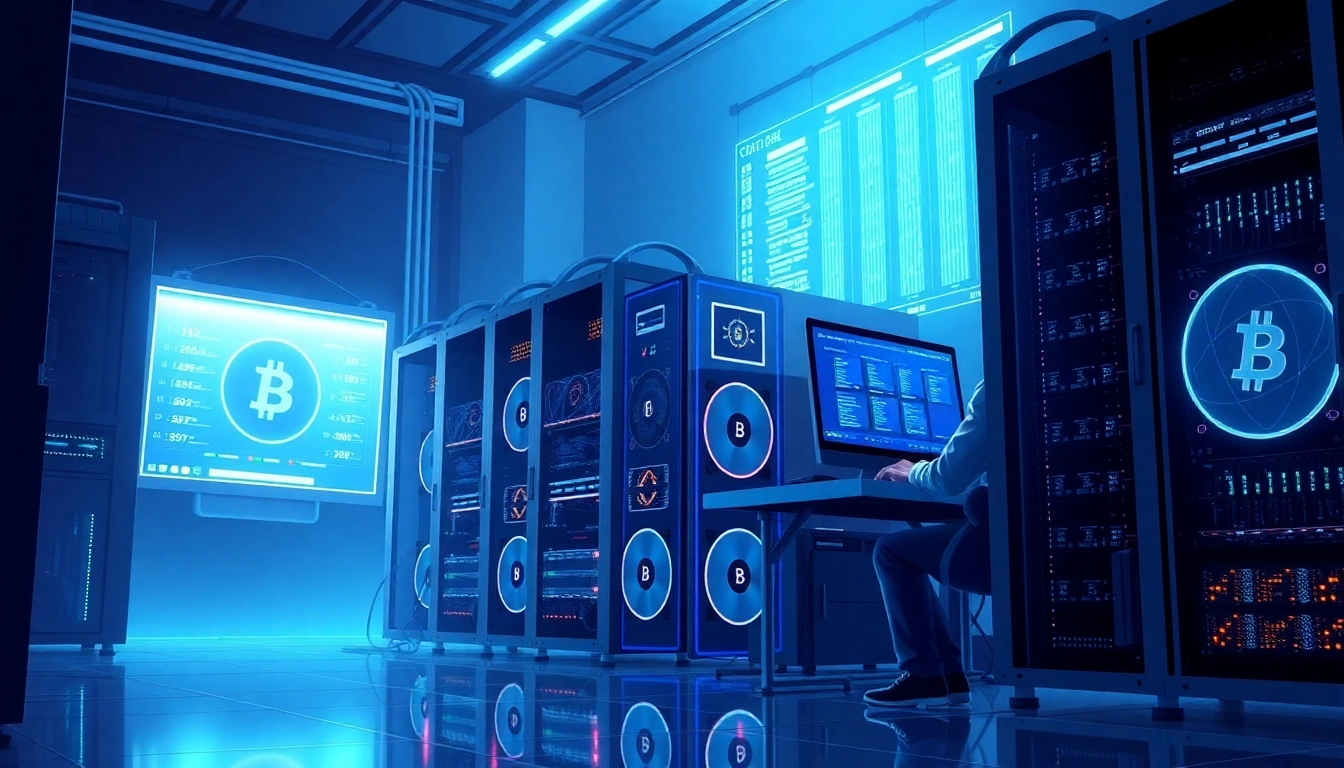Understanding Bitcoin Mining
What is Bitcoin Mining?
Bitcoin mining is a fundamental process that underpins the very existence of the Bitcoin network. At its core, Bitcoin mining involves using computational power to solve complex mathematical problems that validate transactions on the Bitcoin blockchain. When miners solve these problems, they create a new block in the blockchain and are rewarded with newly minted bitcoins and transaction fees. This process not only facilitates the creation of new bitcoins but also ensures the security and transparency of the blockchain, allowing it to function as a decentralized digital currency.
Unlike traditional currencies, Bitcoin operates without a central authority. Instead, it relies on a distributed network of computers (referred to as nodes) to maintain the integrity of the system. Each transaction must be validated by these nodes, and this is where mining comes into play. Miners provide the computational power necessary to verify transactions, making it an essential aspect of how Bitcoin operates. For those looking to understand the intricacies of Bitcoin mining, it is crucial to comprehend both its function and significance within the cryptocurrency ecosystem.
The Role of Miners in the Bitcoin Network
Miners serve a critical role in the Bitcoin network as they ensure the validity of transactions and the overall security of the ledger. Their primary responsibilities include:
- Creating New Bitcoins: Miners are rewarded with new bitcoins for their efforts in solving complex hashing problems. This reward is halved approximately every four years in an event known as the “halving,” which gradually decreases the rate at which new bitcoins are minted.
- Verifying Transactions: Each transaction that occurs on the network is grouped into a block. Miners validate these transactions, ensuring that no double-spending occurs and all participants adhere to the network rules.
- Maintaining Network Security: By adding valid blocks to the blockchain, miners help to secure the network against potential attacks. The computational effort required to alter the blockchain makes it impractical for malicious actors to attempt to modify transaction records.
As the Bitcoin network grows, so too does the competition among miners. This has led to the development of increasingly complex mining hardware and software as miners seek to maximize their profits.
Common Myths About Bitcoin Mining
Despite the growing popularity of Bitcoin mining, there are several myths and misconceptions surrounding the process. Some of the most common include:
- Myth 1: Mining is Only for Tech-Savvy Individuals: While having technical knowledge can help optimize mining efforts, many mining operations offer user-friendly interfaces that allow beginners to participate without extensive technical knowledge.
- Myth 2: Mining is Not Profitable: While profitability can vary based on factors like electricity costs and bitcoin price, many miners have found ways to operate successfully, particularly when using efficient hardware and favorable energy rates.
- Myth 3: You Need Expensive Equipment: While high-end mining rigs can certainly enhance mining efficiency, it’s possible to mine using less expensive hardware, though this may result in lower profits.
How Bitcoin Mining Works
The Technical Process Behind Mining
The technical foundation of Bitcoin mining is rooted in a process called “Proof of Work” (PoW). This consensus mechanism requires miners to compete against one another to solve a cryptographic puzzle known as a hash. The first miner to find a valid hash for a block of transactions broadcasts their solution to the rest of the network.
The hash function used in Bitcoin mining is SHA-256, and it produces a fixed-length output (256 bits) that appears random. The goal is to find a hash that is lower than a predefined target, making the process resource-intensive and time-consuming. If a miner successfully finds a valid hash, they are permitted to add the block of transactions to the blockchain, and in return, they receive a block reward.
Mining Difficulty and Block Rewards
Mining difficulty refers to how challenging it is to find a hash that meets the criteria required to produce a new block. The Bitcoin network adjusts this difficulty approximately every two weeks to ensure that blocks are added at a consistent rate — roughly every ten minutes. This adjustment takes into account the total computational power currently being directed toward mining.
Regarding block rewards, they were initially set at 50 bitcoins per block when Bitcoin was launched in 2009. However, this amount is halved approximately every four years, a process known as “halving.” As of 2023, the block reward has decreased to 6.25 bitcoins. This gradual reduction in rewards helps control the supply of bitcoins and impacts mining economics.
Proof of Work Explained
Proof of Work is a fundamental concept for Bitcoin mining and is what distinguishes the network as decentralized and secure. When a miner successfully solves the cryptographic puzzle, they demonstrate that they have invested computational resources (calculating power) into the network, hence the term “Proof of Work.” This process prevents spamming and malicious activity, as an attacker would require an immense amount of computational power to alter any aspect of the blockchain.
Additionally, Proof of Work ensures that the blockchain remains immutable; once a block is added to the chain, it is incredibly difficult to modify. To alter a single block, an attacker would need to redo the work of both their own block and all subsequent blocks, which is practically impossible without controlling a majority of the network’s mining power (over 51%).
Getting Started with Bitcoin Mining
Choosing the Right Mining Equipment
The first step in starting a Bitcoin mining operation is selecting the appropriate hardware. There are several options to choose from:
- ASIC Miners: Application-Specific Integrated Circuits (ASICs) are highly specialized devices designed solely for Bitcoin mining. They are significantly more efficient than GPU-based systems and are widely considered the best choice for serious miners.
- GPU Miners: Graphics Processing Units (GPUs) can also be used for mining, although they are generally less efficient than ASICs when it comes to Bitcoin. Some miners prefer GPU rigs because they can be repurposed for gaming or other tasks when not mining.
- Cloud Mining: For those hesitant to invest in hardware, cloud mining offers a viable alternative. This service allows miners to rent processing power from a remote data center, minimizing upfront costs.
When selecting mining equipment, it’s crucial to consider factors like hash rate (the amount of computational power), energy consumption, and initial costs. The efficiency of the equipment will significantly impact your potential profitability.
Mining Software Options
Alongside hardware, mining software is necessary to connect your miner to the Bitcoin network. The software facilitates the mining process by managing the mining operation, connecting to the blockchain, and DNS resolution. Popular mining software options include:
- CGMiner: This is one of the most widely used mining software options. It offers a wide range of features and is compatible with ASIC and GPU miners.
- BFGMiner: Similar to CGMiner, BFGMiner is designed for specialized ASIC hardware and allows for great flexibility in usage.
- EasyMiner: This user-friendly option is suitable for beginners as it offers a graphical interface and simplified installation process.
Selecting the appropriate mining software can aid in optimizing performance and increasing potential returns from mining activities.
Setting Up a Mining Pool
Participating in a mining pool is often recommended for new miners due to the competitive nature of Bitcoin mining. A mining pool is a collective of miners who combine their computational resources to improve the chances of successful mining. When the pool successfully mines a block, the block reward is distributed among the participants based on the amount of work contributed.
Joining a mining pool can provide several advantages:
- Consistent Payouts: Mining independently can lead to long periods without finding any blocks. In a pool, members receive more regular payouts based on aggregated efforts.
- Lower Variance: Pool participation lowers the variance in potential income as rewards are distributed over time rather than relying on a single miner’s efforts.
- Social Support: Being part of a community can provide access to valuable insights, tips, and shared experiences in the mining environment.
Bitcoin Mining Economics
Cost Analysis of Bitcoin Mining
The economics of Bitcoin mining are influenced by various factors, including initial hardware costs, electricity prices, cooling expenses, and operational overhead. A comprehensive analysis of these costs is crucial for understanding potential profitability:
- Hardware Costs: Depending on the efficiency and capabilities of the ASIC miner, these costs can range from a few hundred to several thousand dollars.
- Electricity Costs: Mining consumes a substantial amount of electricity. The cost per kilowatt-hour in your location plays a significant role in determining overall expenses.
- Cooling Costs: Mining hardware generates heat, requiring effective cooling systems to prevent overheating. This may involve additional hardware, fans, or air conditioning units.
A thorough understanding of these costs helps in forecasting total expenditure and anticipating the break-even point for a mining operation.
Potential Profitability and ROI
Profitability in Bitcoin mining is not guaranteed, and it varies widely based on the Bitcoin price, mining difficulty, and operational costs. To assess potential returns, miners often use metrics such as ROI (Return on Investment) and cost per coin mined:
- RPM (Revenue Per Miner): Calculating the average revenue generated per miner helps to evaluate profitability.
- Payback Period: Estimating how long it will take to recoup the total investment in mining hardware and set up costs.
Miners use tools like profitability calculators to estimate their earnings based on the current Bitcoin network difficulty, energy costs, and software fees.
Factors Affecting Mining Profits
Several factors contribute to the volatility of mining profitability:
- Bitcoin Price: Fluctuations in the price of Bitcoin directly affect mining income. Higher prices can yield greater profits from mined coins.
- Network Hash Rate: As more miners join the network, the overall hash rate increases, leading to a commensurate increase in mining difficulty, which can impact individual profitability.
- Electricity Costs: Mining in regions with lower electricity rates can significantly enhance profit margins.
The Future of Bitcoin Mining
Emerging Trends in Mining Technology
The landscape of Bitcoin mining is rapidly evolving, with new technologies continuously influencing the industry. Emerging trends include:
- Better Energy Efficiency: As the importance of reducing carbon footprints gains traction, miners are investing in energy-efficient hardware and renewable energy sources to minimize their environmental impact.
- Advanced Cooling Solutions: Innovative cooling technologies, such as immersion cooling, are being explored to optimize operational efficiencies and reduce heat management costs.
- Use of Artificial Intelligence: AI is being implemented to predict market trends and optimize mining strategies, enabling miners to remain competitive in a dynamically changing environment.
Environmental Impact of Mining Operations
The environmental impact of Bitcoin mining has garnered significant attention due to its high energy consumption and carbon footprint. Concerns have prompted discussions around sustainable mining practices:
- Transition to Renewable Energy: Many mining operations are now turning to renewable energy sources (e.g., solar, wind, hydro) to power their rigs, reducing reliance on fossil fuels.
- Carbon Offset Programs: Some miners are investing in carbon offset programs to mitigate their environmental impact, ensuring they play a responsible role in the current climate crisis.
These initiatives are vital not only for preserving ecological balance but also for maintaining the long-term viability of Bitcoin mining.
The Regulatory Landscape for Miners
The legal and regulatory environment surrounding Bitcoin mining is continuously evolving, with jurisdictions around the world implementing various frameworks that can impact mining activities:
- Government Regulations: Some countries have embraced Bitcoin mining as a driver of innovation, while others have imposed strict regulations or outright bans, impacting miners’ operational choices.
- Tax Implications: Miners must consider the tax implications of their operations, both for income generated from mining rewards and for the implied profits from the sale of bitcoins.
As governments grapple with how to regulate cryptocurrency and mining, miners must stay abreast of current laws and regulations that may affect their operations.


